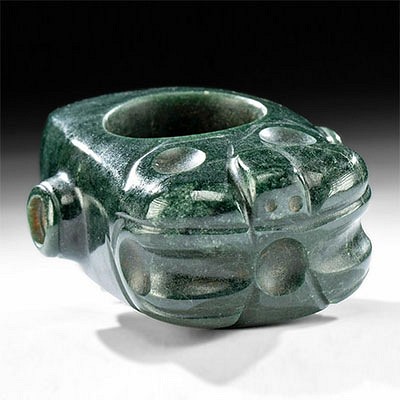Early 20th C. India Bastar Brass Elephant, Howdah, Gods
Lot 65h
About Seller
Artemis Gallery
686 S Taylor Ave, Ste 106
Louisville, CO 80027
United States
Selling antiquities, ancient and ethnographic art online since 1993, Artemis Gallery specializes in Classical Antiquities (Egyptian, Greek, Roman, Near Eastern), Asian, Pre-Columbian, African / Tribal / Oceanographic art. Our extensive inventory includes pottery, stone, metal, wood, glass and textil...Read more
Categories
Estimate:
$1,200 - $1,800
Absentee vs Live bid
Two ways to bid:
- Leave a max absentee bid and the platform will bid on your behalf up to your maximum bid during the live auction.
- Bid live during the auction and your bids will be submitted real-time to the auctioneer.
Bid Increments
| Price | Bid Increment |
|---|---|
| $0 | $25 |
| $300 | $50 |
| $1,000 | $100 |
| $2,000 | $250 |
| $5,000 | $500 |
| $10,000 | $1,000 |
| $20,000 | $2,500 |
| $50,000 | $5,000 |
| $100,000 | $10,000 |
| $200,000 | $20,000 |
About Auction
By Artemis Gallery
Sep 10, 2020
Set Reminder
2020-09-10 10:00:00
2020-09-10 10:00:00
America/New_York
Bidsquare
Bidsquare : Antiquities | Asian | Ethnographic Art
https://www.bidsquare.com/auctions/artemis-gallery/antiquities-asian-ethnographic-art-5546
Featuring classical antiquities, ancient and ethnographic art from cultures encompassing the globe. Egyptian, Greek, Roman, Etruscan, Near Eastern, Asian, Pre-Columbian, Native American, African / Tribal, Oceanic, Spanish Colonial, Russian, Fossils, Fine Art, more! Artemis Gallery info@artemisgallery.com
Featuring classical antiquities, ancient and ethnographic art from cultures encompassing the globe. Egyptian, Greek, Roman, Etruscan, Near Eastern, Asian, Pre-Columbian, Native American, African / Tribal, Oceanic, Spanish Colonial, Russian, Fossils, Fine Art, more! Artemis Gallery info@artemisgallery.com
- Lot Description
Central Asia, India, Bastar, ca. early 20th century CE. A large antique Bastar cast brass ensemble featuring an elephant on wheels who is carrying a howdah (a large basket-like form with a grand canopy) with elaborately decorated deities sitting within and holding various attributes as well as a large platter between them; meanwhile, the mahout, armed with a scepter and a dagger, is seated directly atop the elephant. Every element of this piece displays impressive artistry and technique. The elephant is bedecked with a bejeweled headdress and garlands adorn its legs. The figures are extravagantly dressed and ornamented; and the howdah presents three conjoined parasol-like elements, a fringe of looped applied and openwork motifs, and a stupa finial flanked by two peacocks adoring the top. Interestingly, the artists of this remote area would have only seen such elaborately decorated elephants in rare religious processions. Size: 9" L x 9.5" W x 20.5" H (22.9 cm x 24.1 cm x 52.1 cm)
Special statues of elephants, horses, gods, and goddesses were traditionally created for the Dussehra festival in Jagdalpuer, the Mandei spring festival. Examples very similar to this one were featured in a special exhibition entitled, "Street Parade of the Gods" at the Museum Rietberg in Zurich in July 2012 with pieces from the esteemed collections of former diplomats Hans Kaufmann and Jean-Pierre Zehnder. The author describes the inspiration as, "the 'great meeting of the gods' in Bastar district and it involves hundreds of tribal deities being taken out in a celebratory procession." The article also notes, "their value has grown enormously because the region's tribal traditions are disappearing rapidly." The curator of the exhibition, Cornelia Mallebrein stated, "Things are changing so fast with the tribals dismantling the old mud huts where these bronzes were kept to make cement temples with cement figures. The aesthetic is changing and the whole ritual tradition is vanishing." Mallebrein has conducted field research on tribal traditions in India since 1989. ("Tribal Tryst" in "The Telegraph Calcutta, India" July 22, 2012.)
See a similar example in the collection of the Asian Art Museum Chong-Lee Center for Asian Art and Culture (object number 2005.64.182.a-c).
Provenance: private New Jersey, USA collection; acquired in the early 2000s at an antique show
All items legal to buy/sell under U.S. Statute covering cultural patrimony Code 2600, CHAPTER 14, and are guaranteed to be as described or your money back.
A Certificate of Authenticity will accompany all winning bids.
We ship worldwide and handle all shipping in-house for your convenience.
#151036Piece is comprised of several parts: the elephant, the four wheels, the lower section of the howdah, the seated deities, and the canopy of the howdah. Expected age wear with minute loss to ends of elephants tusks and feet, wheels that are a bit misshapen, show a few cracks and losses, and no longer roll, and a few minor casting flaws to the piece. This said, the form is relatively well preserved for its age and still presents mesmerizing details and a very nice overall form. In addition, the brass has developed a wonderful warm patina over the years.Condition
- Shipping Info
-
All shipping is handled in-house for your convenience. Your invoice from Artemis Gallery will include shipping calculation instructions. If in doubt, please inquire BEFORE bidding for estimated shipping costs for individual items.
-
- Buyer's Premium



 EUR
EUR CAD
CAD AUD
AUD GBP
GBP MXN
MXN HKD
HKD CNY
CNY MYR
MYR SEK
SEK SGD
SGD CHF
CHF THB
THB
















